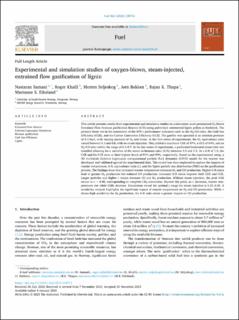| dc.contributor.author | Samani, Nastaran | |
| dc.contributor.author | Khalil, Roger Antoine | |
| dc.contributor.author | Seljeskog, Morten | |
| dc.contributor.author | Bakken, Jørn | |
| dc.contributor.author | Thapa, Rajan Kumar | |
| dc.contributor.author | Eikeland, Marianne Sørflaten | |
| dc.date.accessioned | 2024-01-22T10:15:35Z | |
| dc.date.available | 2024-01-22T10:15:35Z | |
| dc.date.created | 2024-01-18T08:53:18Z | |
| dc.date.issued | 2024 | |
| dc.identifier.issn | 0016-2361 | |
| dc.identifier.uri | https://hdl.handle.net/11250/3113032 | |
| dc.description.abstract | This article presents results from experimental and simulation studies on a laboratory-scale pressurized O2-blown Entrained Flow biomass gasification Reactor (EFR) using pulverized commercial lignin pellets as feedstock. The primary focus lies in the assessment of the EFR’s performance indicators such as the H2/CO ratio, the Cold Gas Efficiency (CGE), and the Carbon Conversion Efficiency (CCE). The gasifier was operated at an absolute pressure of 8.2 bars, with varying amounts of O2 and steam. In the first series of experiments, the O2 equivalence ratio varied between 0.2 and 0.8, with no steam injection. This yielded a maximum CGE of 47%, a CCE of 94%, and an H2/CO ratio within the range of 0.4–0.7. In the last series of experiments, a perforated horizontal steam tube was installed allowing for a variation of the steam-to-biomass ratio (S/B), between 0.5 and 1.5. At a S/B of 1.5, the CGE and the CCE were at their highest levels of 91% and 99%, respectively. Based on the experimental setup, a 3D multiscale Eulerian-Lagrangian computational particle fluid dynamics (CPFD) model for the reactor was developed and validated against the experimental data. This model was then employed to explore the impacts of reactor temperature, S/B, equivalence ratio (λ), and the lignin particle size distribution (PSD) on the gasification process. The findings show that increased reactor temperature enhances H2 and CO production. Higher S/B ratios lead to greater H2 production but reduced CO production. Increased S/B ratios improve both CGE and CCE. Larger particles and higher λ values decrease CO and H2 production. Without steam injection, the peak CGE occurs at λ ≈ 0.45, corresponding to complete CH4 conversion. Beyond this point, as λ increases, reactor temperatures rise while CGEs decrease. Simulations reveal the optimal λ range for steam injection is 0.15–0.35. A sensitivity analysis highlights the significant impact of reactor temperature on H2 and CO production. While λ shows high sensitivity for H2 production, the S/B ratio exerts a greater impact on CO production. | en_US |
| dc.description.abstract | Experimental and simulation studies of oxygen-blown, steam-injected, entrained flow gasification of lignin | en_US |
| dc.language.iso | eng | en_US |
| dc.publisher | Elsevier | en_US |
| dc.rights | Navngivelse 4.0 Internasjonal | * |
| dc.rights.uri | http://creativecommons.org/licenses/by/4.0/deed.no | * |
| dc.title | Experimental and simulation studies of oxygen-blown, steam-injected, entrained flow gasification of lignin | en_US |
| dc.title.alternative | Experimental and simulation studies of oxygen-blown, steam-injected, entrained flow gasification of lignin | en_US |
| dc.type | Peer reviewed | en_US |
| dc.type | Journal article | en_US |
| dc.description.version | publishedVersion | en_US |
| dc.rights.holder | The Authors | en_US |
| dc.source.volume | 362 | en_US |
| dc.source.journal | Fuel | en_US |
| dc.identifier.doi | 10.1016/j.fuel.2023.130713 | |
| dc.identifier.cristin | 2229119 | |
| dc.relation.project | Norges forskningsråd: 328715 | en_US |
| dc.relation.project | Norges forskningsråd: 319723 | en_US |
| dc.relation.project | Norges forskningsråd: 257622 | en_US |
| dc.source.articlenumber | 130713 | en_US |
| cristin.ispublished | true | |
| cristin.fulltext | original | |
| cristin.qualitycode | 2 | |

